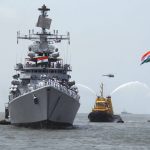INDIAN CAVALRY IN ISRAEL
THE STORY OF A BATTLE MOST INDIANS HAVE NEVER HEARD OF
How many of us know that there are some 800 graves of Indian Soldiers in Israeli soil? A pitiful few may be. The Indian Army does indeed remember these fallen predecessors of World War I by commemorating their heroism every year on the Haifa Day on 23 September; but beyond that the rest of India is hardly aware of this Israeli connection of ours.
Battle of Haifa fought on the 23rd of September 1918 is a landmark event in the history of the creation of the State of Israel. The battle saw the Indian cavalry liberating the port city of Haifa, putting an end to the 400-year old Ottoman rule of the region. This decisive victory of the British-Indian Army over the Ottomans who were siding with Germany eventually led to Britain winning the war itself that put in motion the process that would see the formation of the modern state of Israel in 1948.
The 15th Imperial Service Cavalry Brigade with two regiments, the Jodhpur and the Mysore Lancers, was tasked with capturing Haifa on 23 September 1918. To accomplish the task the brigade needed to take the area extending from Kishon River to Mount Carmel. While the Jodhpur Lancers rode in from the south, the Mysore Lancers made a detour and struck two-pronged from east and north. The Turks defending the town were supported by German machine gunners and Austrian field guns. One column of the Mysore Lancers climbed the steep slope of Mount Carmel and attacked the Austrian battery at 2 p.m, capturing their guns and taking the gunners prisoner. The other column of the Mysore Lancers linked with the Jodhpur Lancers and together they launched an attack on the German machine gun posts from the rear. They took a haul of two machine guns, two camel guns and 30 prisoners. The road to Haifa lay open.
Now the Jodhpur Lancers charged into the town with the Mysoreans giving covering fire. Shortly the latter too charged into the fray. Together they took 1350 German and Ottoman soldiers prisoner and captured an array of artillery and machine guns. One of the last of the horse cavalry charges, it was a magnificent feat of arms wherein the Indian cavalry was at its grittiest best. There is no clear record of the number of Mysore and Jodhpur Lancers who went into action that day. We only know that there are 800 graves of Indian soldiers in Israel.
Taking part in the Haifa Day Celebrations in Delhi in 2013, the then Israeli Ambassador to India, Alon Ushpiz, said, “The heroism, tenacity and cavalry skills of the Mysore and Jodhpur Lancers that took control of the city from the Turks on September 23, 1918 proved to be a decisive factor in the victory over the Ottoman Empire. The historical battle of Haifa paved the way for the victory of the British Army and 30 years later – to the creation of the State of Israel”. Ushpiz, incidentally, was born in Haifa in1966, 48 years after the battle. Haifa today is the third largest city of Israel and the largest of her three major international seaports.
Note: Troops from the Indian (Princely) State Forces who fought the World Wars alongside the British-Indian Army were categorized as ‘Imperial Service Troops’. After independence many of these State Forces units were amalgamated with the Indian Army when their states acceded to the Indian Union.





